China Railway Group Bundle
Who Really Controls China Railway Group?
Understanding the ownership structure of any major corporation is crucial, but it's especially vital when dealing with a construction giant like China Railway Group (CRG). Considering its massive infrastructure projects and global influence, uncovering who owns CRG unveils insights into its strategic direction and market dynamics. This exploration dives into the evolution of CRG's ownership, from its state-controlled origins to its current structure.
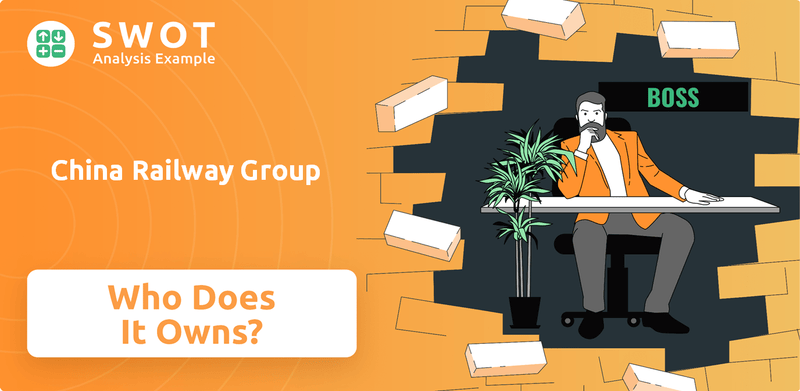
As a prominent player in China's railway system and a key example of Chinese state-owned enterprises, CRG's ownership significantly impacts its operations and strategic decisions. The company's history, including its roots dating back to 1894, and its dual listing on the Shanghai and Hong Kong stock exchanges in 2007, have shaped its current landscape. To gain a deeper understanding of CRG's financial health, consider reviewing a China Railway Group SWOT Analysis.
Who Founded China Railway Group?
The story of China Railway Group (CRG) is deeply intertwined with the Chinese government. While officially established as a joint-stock company in 2007, its roots stretch back to the early days of the People's Republic of China.
The initial ownership of China Railway Group was essentially vested in the state, reflecting its origins within the Ministry of Railways. This structure enabled CRG to undertake massive infrastructure projects, aligning with the nation's strategic goals.
The vision behind CRG, driven by the Chinese government through its state-owned entities, was to create a massive corporate entity capable of handling large-scale national and international projects. This strategy aimed to leverage state backing for significant infrastructure development.
CRG was formally founded on September 12, 2007, as a joint-stock limited company. Its origins trace back to government bureaus formed in 1950.
The primary shareholder at inception was the China Railway Engineering Corporation (CRECG), a state-owned holding company. This reflects the government's direct involvement.
CRG's initial public offering (IPO) occurred in December 2007, with listings on the Shanghai and Hong Kong stock exchanges. The IPO prices varied across the exchanges.
The founders aimed to create a super-large corporate conglomerate. The goal was to undertake massive infrastructure projects globally.
The Chinese government, through CRECG, played a crucial role in CRG's formation and early operations. This ensured alignment with national strategic goals.
CRG was designed to undertake projects both within China and internationally. This strategy aimed to expand its global presence.
The initial structure of CRG clearly indicates its status as a state-owned enterprise. Understanding the Growth Strategy of China Railway Group is crucial for anyone looking to understand its operations and future. The company's close ties to the Chinese government have allowed it to secure significant contracts and undertake large-scale projects. As of 2024, CRG continues to be a major player in the global infrastructure market, with substantial revenues and a workforce exceeding hundreds of thousands. The company's ongoing projects and financial performance reflect its strategic importance to China's economic and geopolitical ambitions. In 2024, CRG's revenue was approximately $160 billion USD, showcasing its substantial market presence. The Chinese government maintains significant control, ensuring alignment with national objectives.
China Railway Group SWOT Analysis
- Complete SWOT Breakdown
- Fully Customizable
- Editable in Excel & Word
- Professional Formatting
- Investor-Ready Format
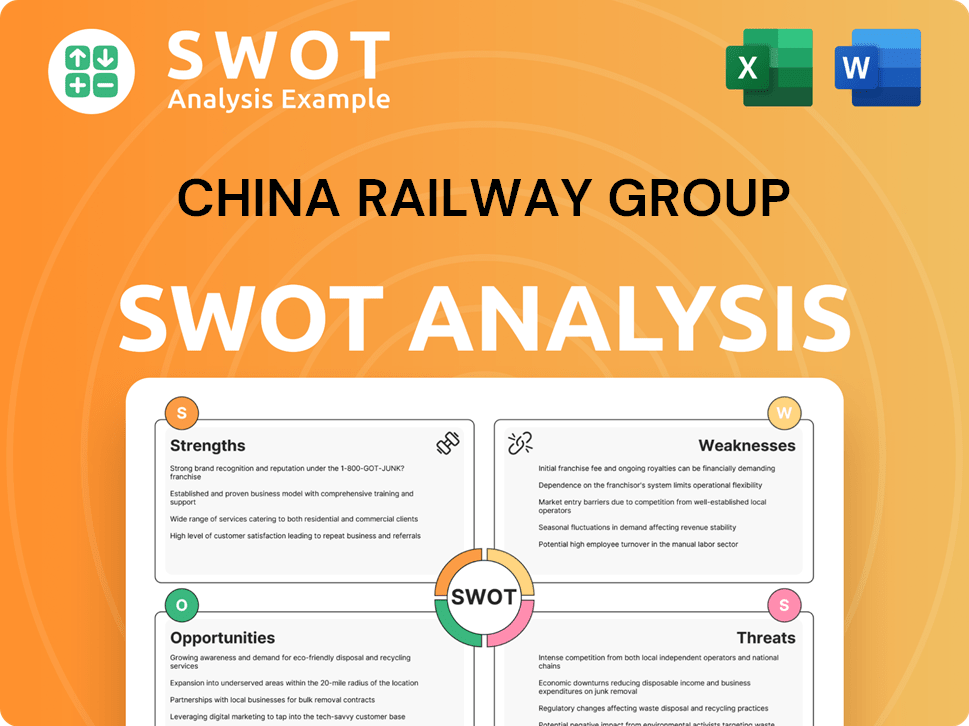
How Has China Railway Group’s Ownership Changed Over Time?
The ownership structure of China Railway Group (CRG) has shifted significantly since its dual IPO in December 2007. Initially fully state-controlled, the company now includes both public and institutional investors. This evolution reflects broader trends in Chinese state-owned enterprises, moving towards a more diversified ownership model while retaining government control. Understanding the dynamics of CRG ownership is crucial for anyone interested in the growth strategy of China Railway Group and its role in China's railway system.
The major shareholder of CRG remains China Railway Engineering Corporation (CRECG), a state-owned entity. CRECG held a significant stake, reported as 54% in 2023, which decreased to 47% in 2024. This indicates a slight shift in ownership, with the share held by CRECG decreasing over time. As of January 2024, private companies, primarily CRECG, held the lion's share, with around 50% ownership.
| Shareholder | Ownership (January 2024) | Notes |
|---|---|---|
| CRECG | ~47% | State-owned, controlling shareholder |
| Individual Investors | ~30% | Publicly traded shares |
| Institutional Investors | ~50.3% | Includes various asset management firms |
Institutional investors play a significant role, holding approximately 50.3% of the total shares outstanding. Key institutional investors include China Securities Finance Corp, China Reform Holdings Corporation Ltd., and China Investment Corp. These major shareholders collectively hold a majority ownership, influencing company decisions. Recent trends show a slight decrease in institutional holdings, with some investors reducing their stakes, while others, like Vanguard, have increased theirs. This dynamic reflects the ongoing adjustments in the ownership landscape of CRG.
CRG's ownership structure is a mix of state control and public investment.
- CRECG remains the major shareholder, but its stake is evolving.
- Institutional investors hold a significant portion of the shares.
- Individual investors also participate in the ownership.
- Ownership changes reflect the dynamic nature of a state-owned enterprise.
China Railway Group PESTLE Analysis
- Covers All 6 PESTLE Categories
- No Research Needed – Save Hours of Work
- Built by Experts, Trusted by Consultants
- Instant Download, Ready to Use
- 100% Editable, Fully Customizable
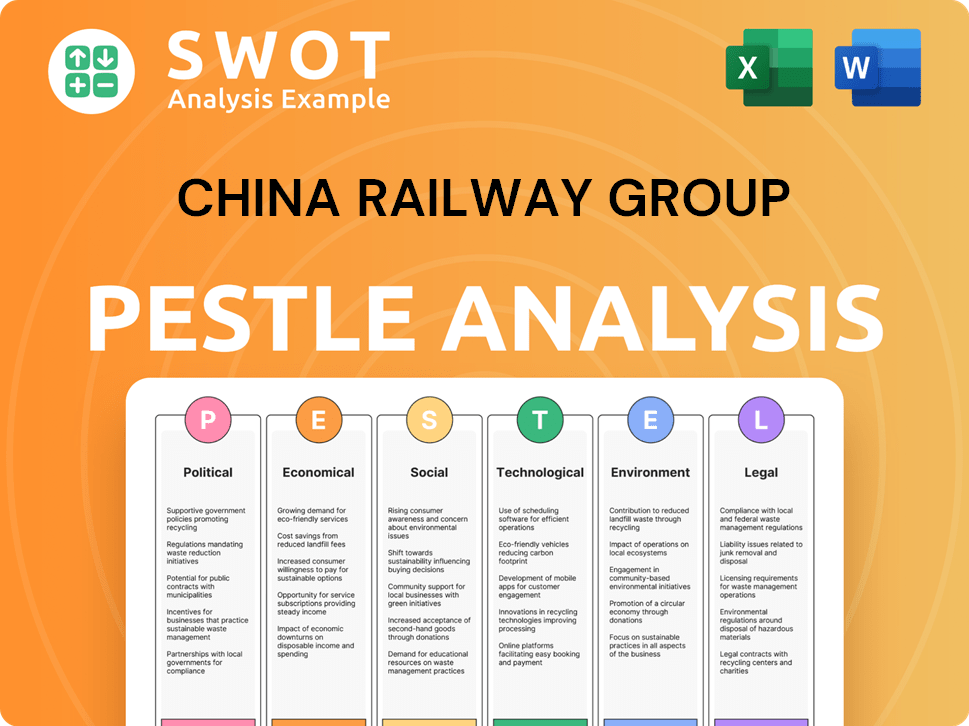
Who Sits on China Railway Group’s Board?
The Board of Directors of China Railway Group (CRG), a key player in China's railway system, is significantly influenced by its major shareholder, China Railway Engineering Corporation (CRECG). As of August 2024, the executive directors include CHEN Yun (Chairman), CHEN Wenjian, and WANG Shiqi. WEN Limin serves as a non-executive director, while XIU Long, SUN Lishi, and TU Haiming are independent non-executive directors. These appointments often reflect the interests of major shareholders, particularly the state. For instance, Mr. Fang Xiaobing's appointment as a non-executive director was a topic for the 2024 Annual General Meeting, scheduled for June 20, 2025. Understanding Marketing Strategy of China Railway Group can provide additional insights into the company's operations.
The board also has several committees, including the Strategy and Investment Committee, Audit and Risk Management Committee, Remuneration Committee, Nomination Committee, and Safety, Health and Environmental Protection Committee, with various directors serving on them. This structure supports structured corporate governance within the company. The composition of these committees and the directors involved are crucial in guiding the company's strategic direction and ensuring compliance with regulations.
| Director Type | Director Name | Date of Appointment (Approximate) |
|---|---|---|
| Executive Director | CHEN Yun | August 2024 |
| Executive Director | CHEN Wenjian | August 2024 |
| Executive Director | WANG Shiqi | August 2024 |
| Non-Executive Director | WEN Limin | August 2024 |
| Independent Non-Executive Director | XIU Long | August 2024 |
| Independent Non-Executive Director | SUN Lishi | August 2024 |
| Independent Non-Executive Director | TU Haiming | August 2024 |
The voting structure generally follows a one-share-one-vote principle, but CRECG's substantial ownership ensures significant state control. The Articles of Association allow for a cumulative voting system when the controlling shareholder's stake exceeds 30% and more than two directors or supervisors are being elected. While this mechanism can influence minority shareholder representation, CRECG's dominant shareholding (approximately 47% as of January 2024) maintains its overarching influence on board decisions. Due to the state-controlled nature of CRG, there have been no widely reported proxy battles or activist investor campaigns.
CRG's Board of Directors is heavily influenced by its major shareholder, CRECG, reflecting the company's status as a Chinese state-owned enterprise.
- The board includes executive, non-executive, and independent non-executive directors.
- The voting structure favors the controlling shareholder, with CRECG holding substantial control.
- The company's commitment to corporate governance is evident through its board committees and shareholder meeting procedures.
- CRG's structure ensures that the Chinese government maintains a significant role in its operations and strategic direction.
China Railway Group Business Model Canvas
- Complete 9-Block Business Model Canvas
- Effortlessly Communicate Your Business Strategy
- Investor-Ready BMC Format
- 100% Editable and Customizable
- Clear and Structured Layout
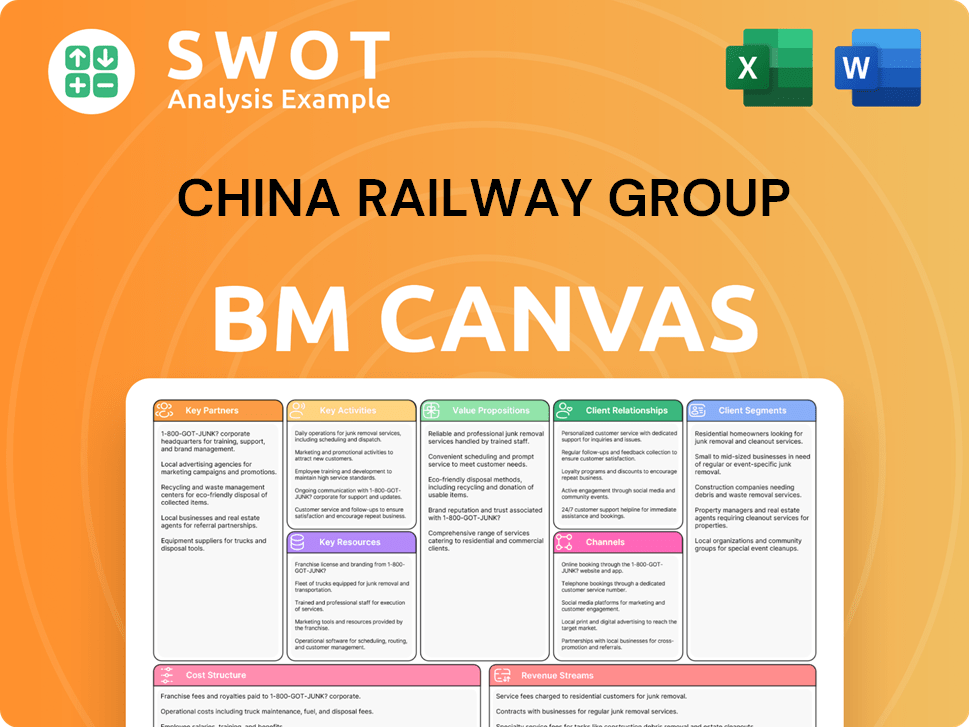
What Recent Changes Have Shaped China Railway Group’s Ownership Landscape?
Over the past few years, China Railway Group (CRG) has maintained its state-owned enterprise (SOE) status while experiencing shifts in its ownership structure and strategic initiatives. In April 2025, the company announced an equity buyback program, intending to repurchase up to CNY 1,600 million worth of its shares, with the goal of reducing its registered share capital. This move, subject to shareholder approval at the June 20, 2025 annual general meeting, underscores a focus on managing its capital structure.
Institutional investors continue to hold a significant portion of CRG's shares, with approximately 65% of outstanding shares as of October 2023, despite a slight decrease in institutional holdings of about 2.1% over the past year. The company has also seen leadership changes, with Mr. CHEN Wenjian appointed as Chairman as of March 12, 2025, alongside adjustments in the board composition, including new independent non-executive directors appointed in August 2024. These developments reflect ongoing efforts to adapt to market dynamics and maintain operational efficiency.
| Metric | Details | Data |
|---|---|---|
| Buyback Program | Maximum Repurchase Value | CNY 1,600 million |
| Share Price Cap | Maximum Price Per Share | CNY 8.50 |
| Institutional Ownership (Oct 2023) | Percentage of Outstanding Shares | Approximately 65% |
| New Contracts Planned (2025) | Value | EUR 357 billion |
| Revenue Target (2025) | Value | EUR 144 billion |
CRG's strategic direction also includes expansion into clean energy investments and aligning with national goals for infrastructure development, digitalization, and carbon reduction. For 2025, the company plans to sign approximately EUR 357 billion in new contracts and aims for EUR 144 billion in revenue, demonstrating its commitment to both domestic and international projects. To gain a broader perspective on the competitive landscape, one can refer to the Competitors Landscape of China Railway Group.
CRG is primarily owned by the Chinese government, reflecting its status as a state-owned enterprise.
The company announced an equity buyback program in April 2025, aimed at reducing share capital.
Institutional investors hold a substantial portion of CRG's shares, although there has been a slight decrease.
CRG is expanding into clean energy and aligning with national infrastructure goals.
China Railway Group Porter's Five Forces Analysis
- Covers All 5 Competitive Forces in Detail
- Structured for Consultants, Students, and Founders
- 100% Editable in Microsoft Word & Excel
- Instant Digital Download – Use Immediately
- Compatible with Mac & PC – Fully Unlocked
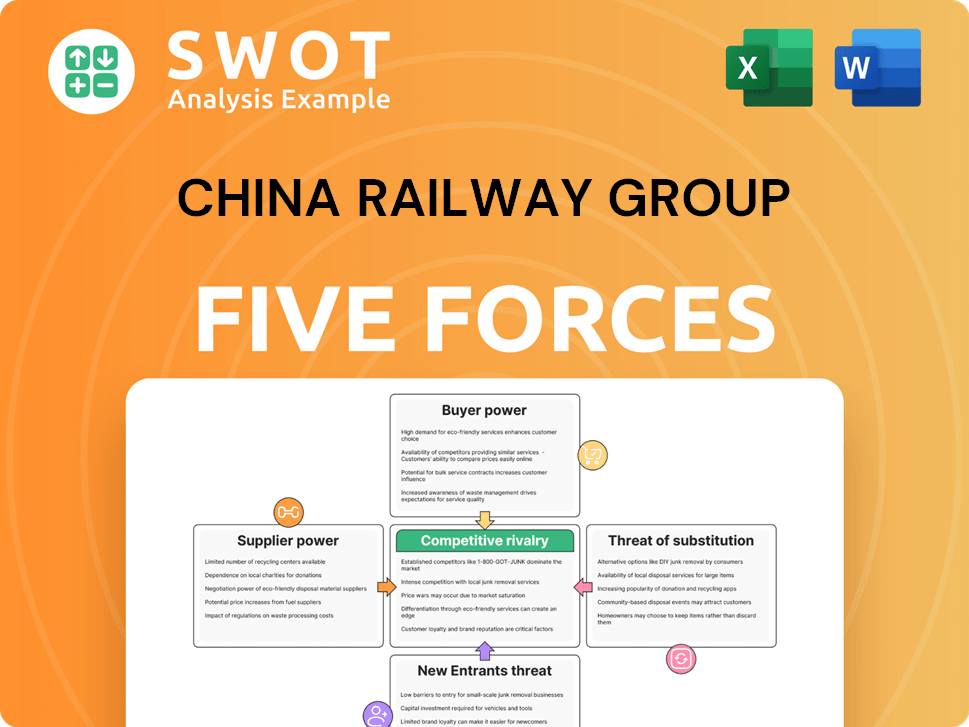
Related Blogs
- What are Mission Vision & Core Values of China Railway Group Company?
- What is Competitive Landscape of China Railway Group Company?
- What is Growth Strategy and Future Prospects of China Railway Group Company?
- How Does China Railway Group Company Work?
- What is Sales and Marketing Strategy of China Railway Group Company?
- What is Brief History of China Railway Group Company?
- What is Customer Demographics and Target Market of China Railway Group Company?
Disclaimer
All information, articles, and product details provided on this website are for general informational and educational purposes only. We do not claim any ownership over, nor do we intend to infringe upon, any trademarks, copyrights, logos, brand names, or other intellectual property mentioned or depicted on this site. Such intellectual property remains the property of its respective owners, and any references here are made solely for identification or informational purposes, without implying any affiliation, endorsement, or partnership.
We make no representations or warranties, express or implied, regarding the accuracy, completeness, or suitability of any content or products presented. Nothing on this website should be construed as legal, tax, investment, financial, medical, or other professional advice. In addition, no part of this site—including articles or product references—constitutes a solicitation, recommendation, endorsement, advertisement, or offer to buy or sell any securities, franchises, or other financial instruments, particularly in jurisdictions where such activity would be unlawful.
All content is of a general nature and may not address the specific circumstances of any individual or entity. It is not a substitute for professional advice or services. Any actions you take based on the information provided here are strictly at your own risk. You accept full responsibility for any decisions or outcomes arising from your use of this website and agree to release us from any liability in connection with your use of, or reliance upon, the content or products found herein.